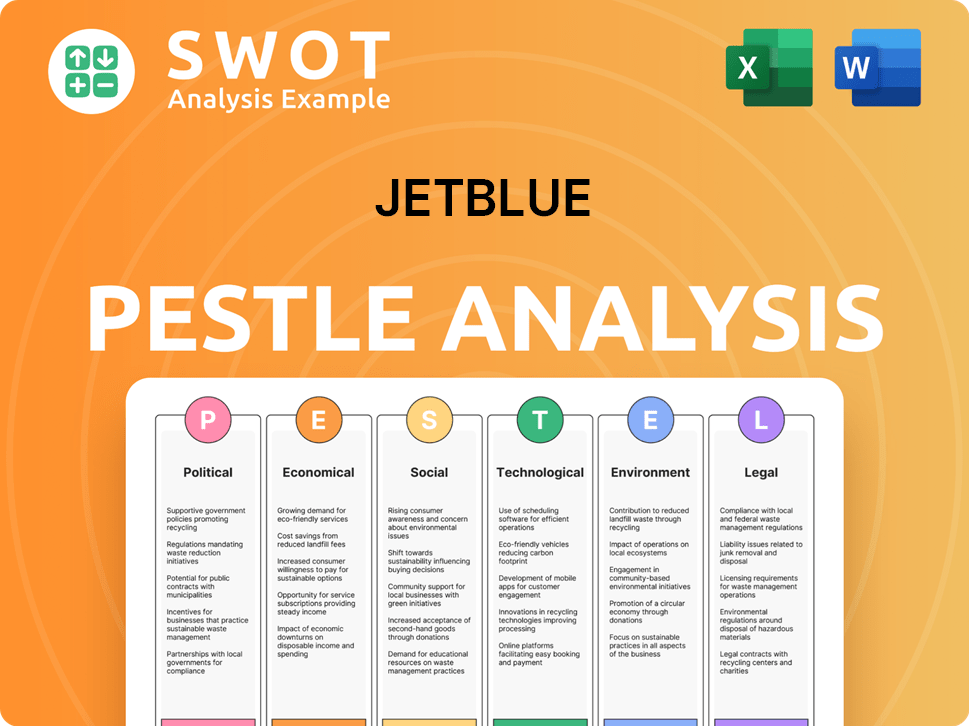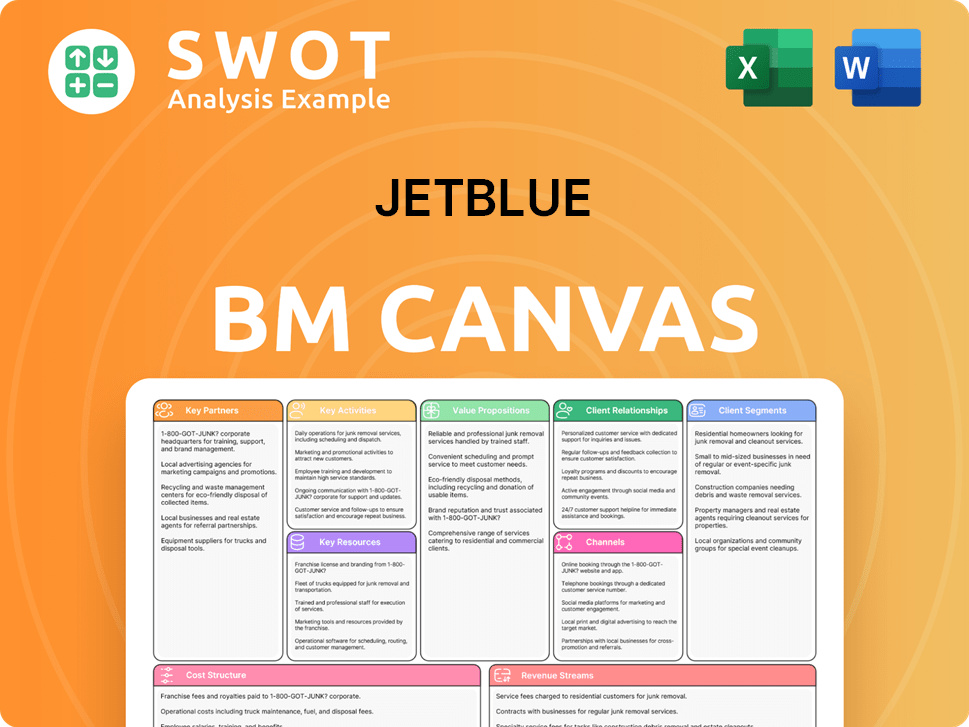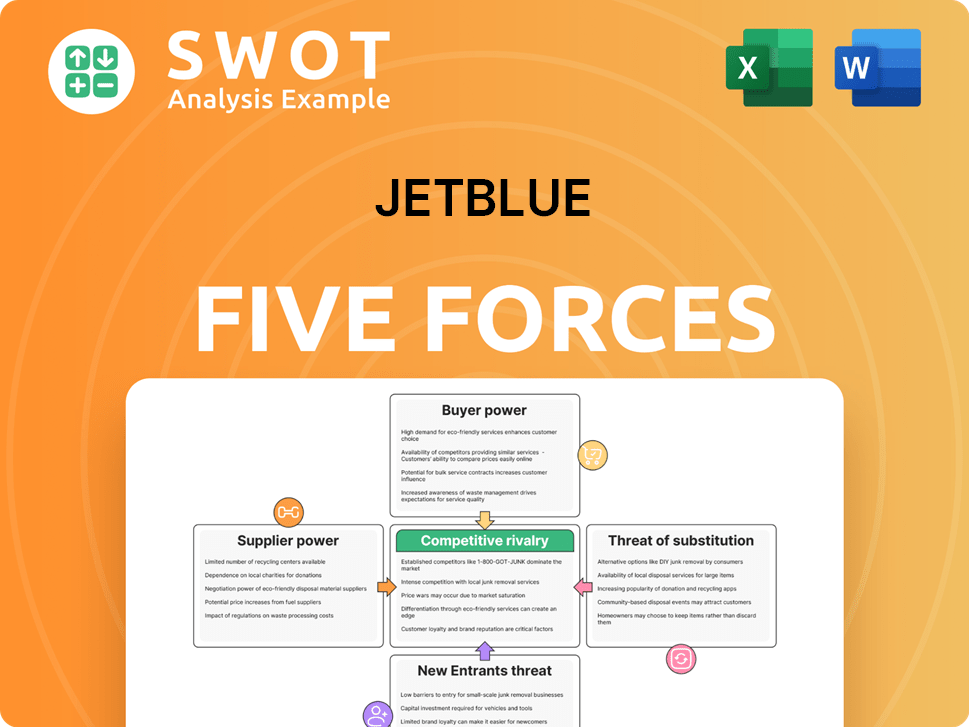JetBlue Bundle
How Does JetBlue Fly High in a Crowded Sky?
JetBlue, a disruptor in the airline industry since 2000, promised 'low fares and great service.' This commitment to customer experience has fueled its growth, setting it apart from competitors. But how does JetBlue maintain its edge in today's dynamic market?

This analysis delves into JetBlue's JetBlue SWOT Analysis, exploring its JetBlue sales strategy and JetBlue marketing strategy to understand its success. We'll examine its JetBlue business model, including JetBlue brand positioning and JetBlue competitive advantage, to see how it captures its JetBlue target market. Discover the innovative strategies behind JetBlue's JetBlue marketing campaigns examples and JetBlue customer acquisition strategy, and how it leverages digital platforms and social media to stay ahead.
How Does JetBlue Reach Its Customers?
The sales strategy of JetBlue revolves around a multi-channel approach, blending online and offline platforms to connect with its customer base. The airline leverages its website, jetblue.com, as a primary e-commerce channel, allowing direct bookings for flights and vacation packages. This digital focus is complemented by strategic partnerships, designed to broaden its reach and enhance customer experience.
JetBlue's marketing strategy emphasizes omnichannel integration and digital adoption to provide personalized experiences and real-time pricing. Its approach includes strategic alliances and the development of platforms like Paisly, which has expanded its services to include customers of other airlines. These efforts are geared towards expanding network reach and offering a wider array of travel options.
JetBlue's sales channels are designed to enhance customer access and convenience, contributing to its overall business model. Through these strategies, JetBlue aims to maintain and grow its market share within the competitive airline industry.
JetBlue's primary sales channel is its website, jetblue.com. This platform allows customers to book flights and vacation packages directly. The website's user-friendly design supports the airline's customer acquisition strategy by providing a seamless booking experience.
Partnerships are a key component of JetBlue's distribution channels. The codeshare enhancement with Etihad Airways, initiated in May 2024, expanded destinations. The 'Blue Sky' collaboration with United Airlines, announced in May 2025, links loyalty programs and expands booking options, improving JetBlue's competitive advantage.
JetBlue's digital marketing strategy focuses on omnichannel integration to offer personalized experiences. This approach includes real-time pricing and targeted promotions. The aim is to enhance customer engagement and drive direct sales, supporting JetBlue's brand positioning.
The Paisly platform, relaunched in January 2025, has evolved into a travel services company. It now serves not only JetBlue customers but also those of other airlines. This expansion increases JetBlue's revenue generation model and broadens its market reach.
JetBlue's sales strategy is designed to maximize customer access and convenience, contributing to its market share growth. This involves a combination of direct sales, strategic partnerships, and digital marketing initiatives. These efforts are focused on enhancing the customer experience and expanding JetBlue's reach within the competitive airline market. To learn more about the competitive landscape, consider reading about the Competitors Landscape of JetBlue.
- Direct Bookings: JetBlue's website is the primary platform for direct bookings.
- Partnerships: Codeshares and collaborations, such as the one with United Airlines, expand network reach.
- Omnichannel Approach: Personalized experiences and real-time pricing are offered through digital channels.
- Paisly Platform: This platform provides travel services to a broader customer base.
JetBlue SWOT Analysis
- Complete SWOT Breakdown
- Fully Customizable
- Editable in Excel & Word
- Professional Formatting
- Investor-Ready Format

What Marketing Tactics Does JetBlue Use?
The marketing tactics employed by JetBlue are multifaceted, leveraging both digital and traditional channels to boost brand awareness, generate leads, and drive sales. The airline's approach is data-driven, aiming to personalize customer experiences and enhance operational efficiency. This comprehensive strategy reflects JetBlue's commitment to innovation and customer-centricity.
JetBlue's digital marketing efforts include content marketing, search engine optimization (SEO), paid advertising, and email marketing. Their omni-channel strategy integrates first-party data for personalized communications. Social media platforms, such as Facebook, X (formerly Twitter), and Instagram, are key for sharing updates and engaging with the audience. The airline also partners with travel influencers and uses user-generated content to build brand loyalty.
A key aspect of JetBlue's strategy is its investment in data analytics to become the 'most data-driven airline in the industry.' This involves technology investments, promoting data literacy, securing data access, and integrating AI across operational teams. This data-driven approach allows for customer segmentation and personalization, offering tailored experiences.
JetBlue's digital marketing strategy encompasses content marketing, SEO, paid advertising, and email marketing. They use an omni-channel approach to personalize communications. The airline leverages social media platforms like Facebook, X, and Instagram for engagement.
JetBlue actively uses social media for updates, promotions, and audience engagement. They use X for customer service, managing flight re-bookings. This has helped reduce hold times and improve customer experience.
JetBlue aims to be the most data-driven airline, investing in technology and data literacy. They use data analytics for customer segmentation and personalization. This includes offering tailored experiences like free Wi-Fi and entertainment.
In April 2024, JetBlue launched 'Blueprint by JetBlue,' a personalized inflight experience. It offers features like group watch parties and content recommendations. This platform also provides personalized greetings and flight connection information.
JetBlue is experimenting with AI-powered virtual assistants for faster customer support. They aim to handle more queries in real-time. A partnership with ASAPP integrates an AI platform to improve customer support efficiency.
While specific recent traditional media campaigns are not detailed, JetBlue still uses in-person events and promotions. The marketing mix emphasizes digital and data-driven personalization, with continuous innovation in customer experience.
JetBlue's JetBlue sales strategy and JetBlue marketing strategy are heavily influenced by its commitment to data-driven personalization. This approach allows for a more targeted and effective JetBlue customer acquisition strategy. The airline's focus on digital channels and social media, including how JetBlue uses social media marketing, is a key component of its overall strategy. For a deeper dive into their approach, consider reading this article on [JetBlue's marketing and sales strategies](0). The airline's JetBlue business model is further enhanced by its ability to leverage data for improved customer service and operational efficiency. This integrated strategy supports JetBlue's market share growth and reinforces its JetBlue competitive advantage.
JetBlue's marketing tactics focus on digital channels, data-driven personalization, and customer engagement. They use content marketing, SEO, paid advertising, and email marketing. Social media and AI-powered customer support are also key components.
- Digital Marketing: Content marketing, SEO, paid advertising, and email marketing.
- Social Media: Active presence on Facebook, X, and Instagram for engagement.
- Data Analytics: Customer segmentation and personalization for tailored experiences.
- AI Integration: AI-powered virtual assistants for customer support.
- Partnerships: Collaboration with travel influencers and use of user-generated content.
JetBlue PESTLE Analysis
- Covers All 6 PESTLE Categories
- No Research Needed – Save Hours of Work
- Built by Experts, Trusted by Consultants
- Instant Download, Ready to Use
- 100% Editable, Fully Customizable

How Is JetBlue Positioned in the Market?
JetBlue's brand positioning centers on offering 'low fares and great service,' a strategy that sets it apart in the airline industry. This approach emphasizes customer comfort and a superior in-flight experience, including spacious seating and entertainment options. The goal is to make air travel enjoyable and memorable, differentiating itself from other low-cost carriers.
The airline's visual identity and voice are designed to be 'joyful, fun, and contemporary.' This brand expression is consistently applied across all channels, from digital platforms to physical spaces, ensuring a cohesive passenger experience. This focus on value, innovation, and customer-centricity helps JetBlue appeal to its target market effectively. This is a key element of its Revenue Streams & Business Model of JetBlue.
JetBlue's Mint Service, offering 'affordable luxury' on select flights, further enhances its brand positioning by catering to a broader range of customers while maintaining high-quality service. This strategy allows JetBlue to capture different market segments and maintain its competitive edge.
JetBlue differentiates itself with a unique selling proposition (USP) focused on providing a premium experience at an affordable price. This includes spacious seating, exceptional in-flight entertainment, and attentive customer service. This approach is central to its JetBlue sales strategy and brand identity.
Customer satisfaction is a key focus for JetBlue. The airline actively monitors online reviews and social media to address issues and improve services. This responsiveness is crucial for maintaining customer loyalty and enhancing its JetBlue marketing strategy.
JetBlue maintains brand consistency across all channels, from digital platforms to physical spaces, ensuring a cohesive passenger experience. This consistency reinforces its brand message and enhances customer recognition. This is a key element of its JetBlue business model.
JetBlue focuses on innovation and providing value to its customers. The introduction of services like Mint demonstrates its commitment to offering premium experiences at affordable prices. This approach supports its JetBlue competitive advantage.
JetBlue's brand positioning has earned it significant recognition. In 2024, it received the 'Design Airline of the Year North America' award from TheDesignAir for its innovative design and superior travel experience. In the J.D. Power 2025 North America Airline Satisfaction Study, JetBlue ranked highest in customer satisfaction in the first/business segment and second in both premium economy and economy/basic economy segments. The airline's Net Promoter Score (NPS) improved double digits year-over-year in Q1 2025, marking four consecutive quarters of growth, which JetBlue views as a strong indicator of customer retention and brand loyalty. These accolades reflect the success of its brand strategy and its ability to connect with its JetBlue target market.
JetBlue Business Model Canvas
- Complete 9-Block Business Model Canvas
- Effortlessly Communicate Your Business Strategy
- Investor-Ready BMC Format
- 100% Editable and Customizable
- Clear and Structured Layout

What Are JetBlue’s Most Notable Campaigns?
In 2024 and 2025, several key campaigns have been central to the sales and marketing efforts of the airline, all aimed at enhancing customer value, optimizing operational efficiency, and driving sustainable growth. These initiatives are designed to strengthen the airline’s market position and improve its financial performance. The overarching goal is to reinforce the airline's brand and customer loyalty.
The airline's strategic focus includes initiatives to enhance customer experiences, such as the 'Blueprint by' platform, and revamp loyalty programs. These efforts are coupled with operational improvements like network optimization and cost management to ensure long-term profitability. These strategic campaigns are crucial for maintaining and growing its market share.
These strategic initiatives are integral to the airline's business model, designed to enhance its competitive advantage and drive revenue growth. By focusing on customer-centric solutions and operational excellence, the airline aims to solidify its position in the competitive airline industry. For a deeper understanding of the airline's growth strategy, read more at Growth Strategy of JetBlue.
The 'JetForward' strategy, launched in 2024, focuses on enhancing reliability, optimizing the East Coast network, upgrading product offerings, and maintaining cost competitiveness. This campaign is projected to generate an additional $800-$900 million in earnings before interest and taxes (EBIT) from 2025 through 2027. The airline optimized approximately 20% of its network in 2024, closing 15 'BlueCities' and launching new service to several others.
Launched in April 2024, the 'Blueprint by' platform offers customers more customizability. This initiative includes new inflight entertainment features, such as group watch parties and saved content. This campaign highlights the airline's commitment to innovation and customer-centricity, furthering its award-winning onboard experience.
The revamped TrueBlue loyalty program, redesigned for 2024, includes new tiers like Mint and Ultra Mint and 'Jetsetter' status. These tiers offer perks such as complimentary bags, seat upgrades, and lounge access, targeting high-value travelers. Loyalty revenue increased by 9% year-over-year in the first quarter of 2025.
The enhancement of the 'Blue Basic' offering, allowing customers to bring a complimentary carry-on bag, launched in Fall 2024. This change aims to appeal to price-conscious consumers and improve the value proposition. The airline also plans to evolve its 'Even More Space' seats into 'EvenMore' in 2025.
JetBlue Porter's Five Forces Analysis
- Covers All 5 Competitive Forces in Detail
- Structured for Consultants, Students, and Founders
- 100% Editable in Microsoft Word & Excel
- Instant Digital Download – Use Immediately
- Compatible with Mac & PC – Fully Unlocked

Related Blogs
- What are Mission Vision & Core Values of JetBlue Company?
- What is Competitive Landscape of JetBlue Company?
- What is Growth Strategy and Future Prospects of JetBlue Company?
- How Does JetBlue Company Work?
- What is Brief History of JetBlue Company?
- Who Owns JetBlue Company?
- What is Customer Demographics and Target Market of JetBlue Company?
Disclaimer
All information, articles, and product details provided on this website are for general informational and educational purposes only. We do not claim any ownership over, nor do we intend to infringe upon, any trademarks, copyrights, logos, brand names, or other intellectual property mentioned or depicted on this site. Such intellectual property remains the property of its respective owners, and any references here are made solely for identification or informational purposes, without implying any affiliation, endorsement, or partnership.
We make no representations or warranties, express or implied, regarding the accuracy, completeness, or suitability of any content or products presented. Nothing on this website should be construed as legal, tax, investment, financial, medical, or other professional advice. In addition, no part of this site—including articles or product references—constitutes a solicitation, recommendation, endorsement, advertisement, or offer to buy or sell any securities, franchises, or other financial instruments, particularly in jurisdictions where such activity would be unlawful.
All content is of a general nature and may not address the specific circumstances of any individual or entity. It is not a substitute for professional advice or services. Any actions you take based on the information provided here are strictly at your own risk. You accept full responsibility for any decisions or outcomes arising from your use of this website and agree to release us from any liability in connection with your use of, or reliance upon, the content or products found herein.